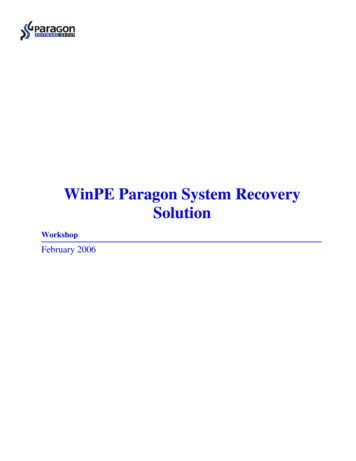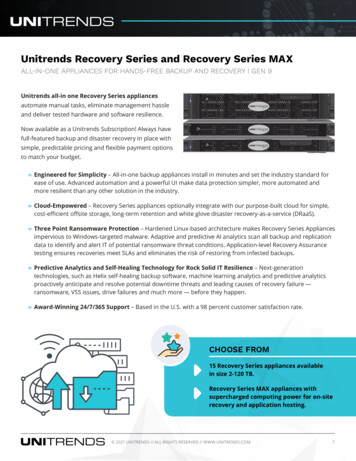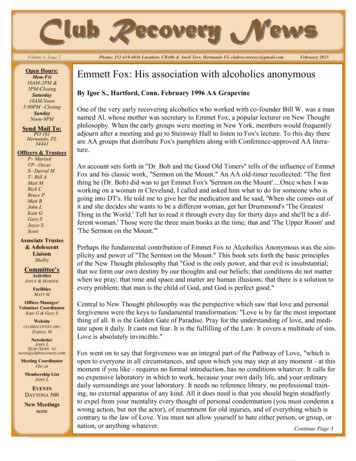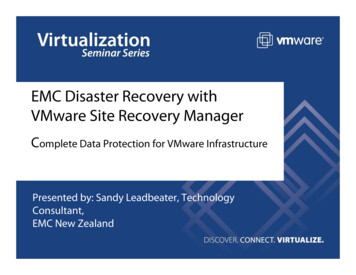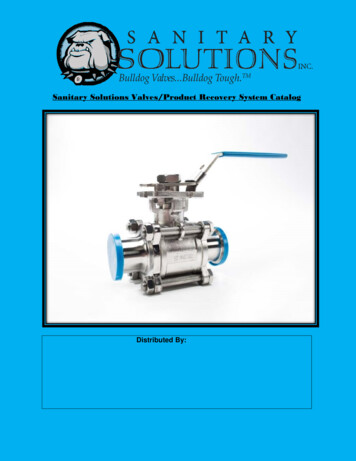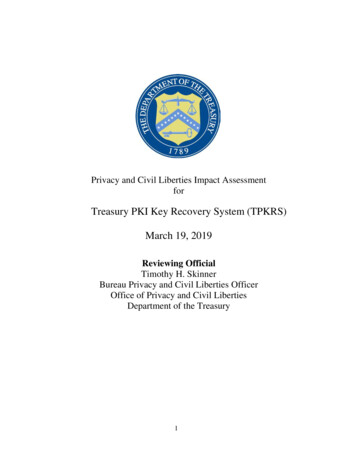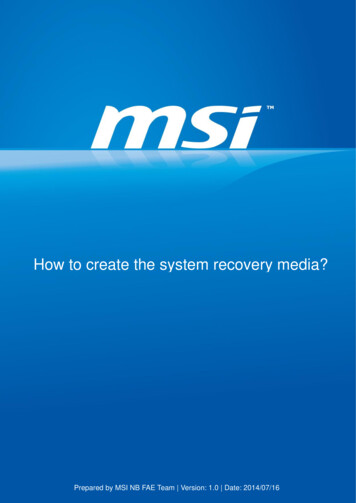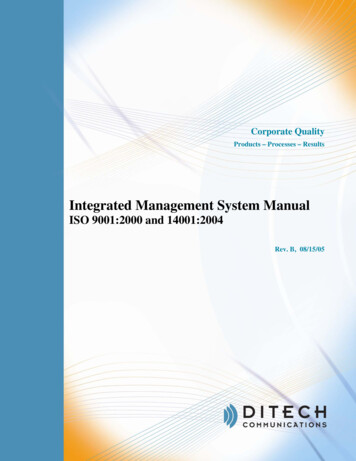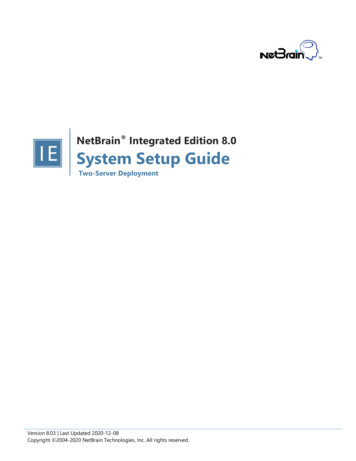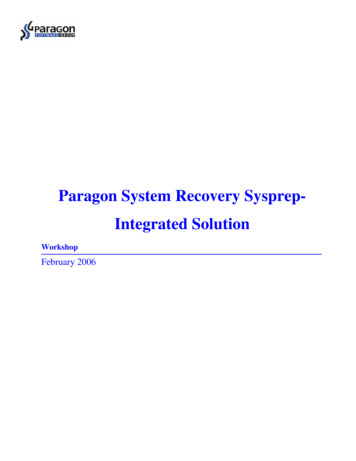
Transcription
Paragon System Recovery SysprepIntegrated SolutionWorkshopFebruary 2006
Table of ContentsParagon System Recovery General Scheme . 3Introduction . 4Overview . 4Terms. 5PSR Sysprep-Integrated solution . 6PSR Sysprep-Integrated Workflow Diagram. 7How it works . 8Preparation . 8Command line execution. 12PSRSysprep.msi command line execution. 12Sysprep utility command line execution . 12Backup Operation. 14Restore Operation. 17HDD Cloning Issues for HDD-Based Solution with PSR-on-Board. 19System Requirements. 21HDD-Based Solutions . 21CD/DVD-Based Solutions . 21Summary and Conclusion . 22
Paragon System Recovery General SchemePSR 7.1Backup the systempartition or entire HDDHDD-Based Solution (theimage is located in BackupCapsule on the HDD)CD-Based Solution (the imageis located on the CD/DVD diskand restoration is possible fromthis bootable CD/DVD disk)HDD-Based Solution withPSR-on-Board (possibility torestore the system withoutRecovery CD/DVD)HDD-Based Solution withoutPSR-on-Board (possibility torestore the system frombootable Recovery CD only)Select Backup ModeSysprep-Integration (syspreputility is started under Windowsto reseal)Backup from WinPE PSR CDCustomizable ModeIntegration by manual pressingof the “Reseal” button.Batch mode for integration withautomated process.Manual * or Batch modeWindows, WinPE support;Manual Mode;Batch Mode.* At the present time, the PSR-on-Board feature is disabled in the manual HDD-Based Solution for WinPE PSR.
Paragon System Recovery (PSR) includes the following components: PSRSysprep.MSI file (Sysprep-Integration Mode); WinPE PSR CD ; Recovery CD for HDD-Based Solution without PSR-on-Board; Supplementary Package for integration into the custom technology process that includes:-Post-cloning patcher for PSR-on-Board solution (see for more info);-Backup package that may simplify integration in the custom technology process.IntroductionThis workshop describes the step-by-step instruction on how to use PSR Sysprep-Integratedsolution (for other Backup Mode, see corresponding workshops) to prepare computers with thepossibility to restore Windows operating system and the entire hard disk to the initial state,including all the customizations, at any time without or with complementary tools.This solution is fully automated and specifically intended for OEMs (original equipmentmanufactures) who produce computers and preinstall operating systems, and who need to supplyrecovery tools to end-users with the possibility to recovery Windows operating system or entire harddisks.This solution can be widely used not only by OEMs but also by system integrators andVARs (value added resellers) who customize computer systems for their clients. All these systembuilders can get the obvious benefits of using the solution since it allows them to increase efficiencyof their customer relationship process by providing their customers with a convenient and reliabletools for automatic system restoration.OverviewComputers with PSR Sysprep-Integrated Solution are supplied to end-users and allow themto restore the system to the initial state without or with additional tools (CD/DVD) in case of severesystem damage. PSR Sysprep-Integrated solution provides with a technology to create a systembackup (disk or partition), secure zone on a local disk (Backup Capsule) at the end of the hard diskto store the backup archive and the program loader to restore this backup archive at PC boot in a fastand easy way. The technology also provides the possibility to burn system backups to bootableCD/DVD medias and restore them by booting from these CD/DVD.
End-users can fully automatically restore the system to the initial state by pressing the Altbutton at PC boot or by booting from the CD/DVD.TermsRecovery CD/DVD is supplied with a new computer and allows the end user to restore thesystem to the initial state in case of severe system damage. There are two types of RecoverCD/DVD: with a backup image and without it. The PSR provides the OEM with a technology tocreate the Recovery CD/DVD with a backup image in a fast and easy way (Recover CD/DVDwithout a backup image is already supplied with PSR). On the end-user side, usage of theseRecovery Discs is also as fast and easy as possible. The Recovery Discs are bootable and in case ofcontaining backup images (partition or entire HDD) are very useful if it is not necessary to storebackup images on local Hard Disks. The process of restoration can be totally automated without thenecessity for the end user to be involved.Backup Capsule is a secure zone on the hard disk (usually a separate hidden partition)where PSR Sysprep-Integrated solution can save its backup archives and restore module (programloader: PSR-on-Board).It is assumed that PSR Sysprep-Integrated solution will be used with the SystemPreparation Tool (sysprep utility). The sysprep utility is designed for system administrators,Original Equipment Manufacturers (OEMs), and others who must automatically deploy WindowsOS on multiple computers. The utility is used to remove all user-specific information from a sourcecomputer and prepare its hard disk for duplication to target computers. It configures the operatingsystem to run Mini-Setup when the end user starts the computer for the first time since purchasing.Mini-Setup is a wizard that runs when a computer boots for the first time since purchasingor, in other words, since the hard disk was duplicated. By asking the end user or taking answersfrom configuration files, this wizard gathers the information that is needed for the operating systemto be activated and to adjust itself to the end user.
PSR Sysprep-Integrated solutionPSR Sysprep-Integrated solution offers different scenarios for backup/restoring the systempartition or entire disk. These solutions differ form each other in methods of storing backup archives(on CD/DVD or local HDD) and in methods of restoring them (from HDD or CD/DVD): HDD-Based Solution with PSR-on-Board – The backup image (partition or disk) is locatedin Backup Capsule on the local hard disk. It is possible to restore the system withoutRecovery CD/DVD by pressing Alt button at PC boot;Note: This solution imposes a limitation on disk cloning after the backup is finished. Pleasesee the HDD Cloning Issues for HDD-Based Solution with PSR-on-Board chapter for moreinformation. HDD-Based Solution without PSR-on-Board - The backup image (partition or disk) islocated in Backup Capsule on the local hard disk. It is necessary to have Recovery CD/DVD(which is supplied with PSR) to restore the image; CD-Based Solution – The image (partition or disk) is located on the CD/DVD and restore ispossible by booting from this CD/DVD.Note: All these solutions should meet reasonable system requirements that are described below.If it is difficult to meet these requirements, use WinPE PSR Solution that removes all theserestrictions.
PSR Sysprep-Integrated Workflow DiagramStarting PSRSysprep.MSIBackup the system partition only(other partitions will not bechanged after restoring)Backup the entire Hard Disk (allpartitions will be restored to theinitial state)Step 1:Source SelectingBackup to BackupCapsule on the localHard Disk. Possibility torestore by pressing Alt during booting thecomputer or fromRecovery CD (theRecovery CD doesn’tcontain the archive)Backup to BackupCapsule on thelocal Hard Disk.Possibility torestore fromRecovery CD (theRecovery CDdoesn’t contain thearchive)Burn thebootableRecovery CD/DVD with thearchiveStep 2:Destination SelectingStep 3:PSRSysprep FinishingFinishing PSRSysprep.msiinstallationStep 4:Sysprep Utility ExecutingExecuting sysprep.exeutilityStep 5:BackupBackup operation (on HDDor CD/DVD)After executing the utility,PC will be rebootedIn case of severe systemdamage, a user can alwaysrestore the systemStep 6:RestoreRestore operationUser can restore the systemas many times as it is needed
How it worksPreparation1. Assemble a computer, install an operating system on the hard disk and all necessary driversand additional applications.2. Make ready the PSRSysprep.msi file by copying it to any place in your network or yourlocal disk, for example to the C:/PSR folder.Note: The supplied MSI file is to be installed under Windows and no product traces remainafter installation is completed.3. Double click on the PSRSysprep.msi file to launch the installation wizard.
4. Press Next to proceed.5. In the appeared dialog, it is necessary to select the backup source either the system partitionor the entire Hard Disk.6. After selecting either of the sources and pressing the Next button you will see the followingdialog:
As shown in the picture above, there are three different destinations for the archive to select: Backup into the Backup Capsule on the HDD. Possibility to restore by pressing Alt during computer booting or from Recovery CD (the Recovery CD doesn’tcontain the archive); Backup into the Backup Capsule on the HDD. Possibility to restore from RecoveryCD (the Recovery CD doesn’t contain the archive); Burn the bootable Recovery CD/DVD with the archive.By selecting one of the offered options, you define the backup operation that will beexecuted at PC reboot. See Backup Operation in the next chapter.7. Select the destination and press Next and then Install.8. Press the Finish button to finish the installation.After installing the PSRSysprep.msi file, a special process will be started to interceptthe next rebooting for starting our special backup script. Moreover, the Sysprep folder in theroot of the system partition will be created.9. Make ready the System Preparation Tool (sysprep) to automate the successful deployment ofMicrosoft OS on an end-user side.10. Double-click on the sysprep.exe file to run it.
11. For the Reseal operation set the Reboot option in the Shutdown pop up menu and press theReseal button.Note: After pressing the Reseal button, you should see Windows Console (CMD.exe) dialog(for 1 or 2 sec.) confirming that you have successfully integrated the PSR solution with the SystemPreparation Tool (Sysprep).
Command line executionYou can also execute the PSRSysprep.msi file and Sysprep.exe utility via the commandline.PSRSysprep.msi command line executionTo execute the PSRSysprep.msi file in the command line or command prompt, use thefollowing pattern and options:msiexec /i " PathToMSI " /q SOURCE " SrcPar " DESTINATION " DestPar "where: PathToMSI - path to the PSRSysprep.msi file; SrcPar takes on the following values: Partition – to backup the system partition; HDD – to backup the first hard disk. DestPar takes on the following values: BCwithPSRonBoard – to backup the specified source to Backup Capsule togetherwith PSR-on-Board installation; BCwithoutPSRonBoard - to backup the specified source to Backup Capsule withoutinstalling PSR-on-Board; CD/DVD - to burn the specified source to the bootable Recovery CD/DVD disk;For example:msiexec/i"C:\PSR\PSRSysprep.msi"/qSOURCE "Partition"DESTINATION "BCwithPSRonBoard" - Backup the system partition to BackupCapsule on the first hard disk with possibility to restore by pressing Alt during computerbooting (PSR-on-Board installed) or from Recovery CD (the Recovery CD doesn’t containthe archive).Note: The SOURCE and DESTINATION parameters must be in uppercase characters.Sysprep utility command line executionIf you are going to run the sysprep.exe utility via the command line or command prompt, youshould start the C:\Sysprep\Backup\do runbs.bat file before executing the sysprep.exe one.
After executing the do runbs.bat file, which initiates Bluescreen at the next reboot, you can runthe sysprep.exe utility via the command line or command prompt. For example, if you want toperform the Reseal operation via the command line you should click Start, then click Run and typethe following in the Open box:C:/Sysprep1/sysprep.exe –reseal -quite –reboot
Backup OperationAfter the sysprep.exe utility is completed, the PC will be rebooted in the BlueScreen mode(you can usually see BlueScreen mode at PC boot if it is necessary to check files systems on thelocal disks) to perform operations depending on the following: If you have selected the HDD destination with the possibility to restore by pressing Altbutton or Recovery CD/DVD the following operations will be performed:-Backup Capsule creation;-Creation of backup archive (system partition or the entire hard disk) in BackupCapsule;-Creation of the special restore module in Backup Capsule. The restore module isused to launch PSR-on-Board engine for restoring the backup archive;-Set the special boot manager (PSR-on-Board loader) to the first track to be able topass the control to the restore module without any additional tools in case of severesystem damage.
If you have selected the HDD destination with the possibility to restore from RecoveryCD/DVD only, the following operations will be performed:-Creation of Backup Capsule;-Creation of backup archive (system partition or the entire hard disk) in BackupCapsule. If you have selected burning the bootable Recovery CD/DVD with the archive, thefollowing operations will be performed:-Creation of Recovery CD/DVD with PSR loader;-Burning of backup archive (system partition or the entire hard disk) to RecoveryCD/DVD.After any of the operation is completed, the PC will be automatically switched off and readyfor supplying to end-users.Note: If the PC is not switched off after the operations are completed, it follows that someerrors occurred while processing the operations.
Note: After booting the PC, you will see the following Mini-setup wizard:
Restore OperationIn case of system crash or any severe damage, a user can always restore the system byrestoring the system backup (partition or disk) from Backup Capsule or Recovery CD/DVD.After using PSR Sysprep-Integrated solution to create the backup archive, there are severalways to restore the system, which are depended on the destination chosen during the backupoperation: Restoration by pressing the Alt button at PC boot (backup image and PSR-on-Boardengine are on Backup Capsule); Restoration by booting from Recovery CD/DVD (backup image is on BackupCapsule or Recovery CD/DVD).After pressing the Alt button at PC boot or booting from Recovery CD/DVD, you will seethe first Paragon System Recovery dialog with the following attention massage:Press OK to proceed.After pressing OK, you will see the next dialog that will show the progress bar of the restoreoperation from Backup Capsule.
After finishing the restore operation, you will see the following dialog:Press OK to reboot and finish the restore operation.
HDD Cloning Issues for HDD-Based Solution with PSR-on-BoardAfter preparing a computer and backing up the system partition or entire disk to BackupCapsule, you can easily clone the computer’s disk for other target computers.However please note that there is the only one condition - the first track must be copied toobecause it contains PSR-on-Board loader. In case, the software, that is used to clone the disk, doesnot copy the first track you should patch the disk, which was cloned, by the appropriate utility fromthe UpdatePSRLoader package (it depends on operating system you are running). TheUpdatePSRLoader package contains three folders for different operating systems: Windows, Linuxand DOS.For example, you are running Windows OS and you have cloned a disk without the firsttrack. To update the first track you should start the do setbm.bat file from the Windows folder inthe UpdatePSRLoader package.
After running the do setbm.bat file you should see the following confirmation message:Note: The do setmb.bat batch file starts Paragon Script Interpreter (psi win.exe) to executethe setbm.psl script file in the scripts folder. The setbm.psl script file scans all local disks and alltheir partitions for Backup Capsule. Only the first disk with Backup Capsule will be patched torecover PSR-on-Board loader to the first track.
System RequirementsHDD-Based SolutionsLet us consider different disk layouts.1. The system partition is single or last on the hard disk.-The system partition should be NTFS;-At the end of the hard disk should be non-partitioned space to create Backup Capsulewith the image. After the backup operation is completed, the system partition will beenlarged up to the end of the hard disk.Example: Hard disk size is 100GB. There is a single NTFS system partition of 30GB on thishard disk. Used space of this system partition is 5GB. This configuration is acceptable andafter image creating, the system partition will be enlarged up to approximately 95GB. Thelast 5GB will be allocated for Backup Capsule with the backup archive.2. There are several partitions on the hard disk and the system partition is not last.-(Free space on of the last partition) (non-partitioned space at the end of the hard disk)must be larger than the used space of the system partition. After the backup operation iscompleted, the last partition will be enlarged up to the end of the hard disk. If there is nonon-partitioned space at the end of the hard disk then the last partition will be shrunk.Example: Hard disk size is 100GB. There are two partitions on the hard disk: the firstpartition (system) has 30GB size, the second (non-system) one has 70GB. The used space ofthe first partition is 15GB. Free space of the second partition is 60GB. This configuration isacceptable and after image creating, the second partition will be shrunk up to approximately55GB. The last 15GB will be allocated for Backup Capsule with the backup archive.CD/DVD-Based SolutionsUnfortunately, the BlueScreen mode does not support USB CD/DVD drives. Itfollows that you cannot burn Recovery CD/DVD in the BlueScreen mode using USBCD/DVD drives.
Summary and ConclusionSince the process of system recovery takes place on the end user side, it should be as simple aspossible. The end user prefers to understand what is going on with
Starting PSRSysprep.MSI Step 1: Source Selecting Backup the system partition only (other partitions will not be changed after restoring) Backup the entire Hard Disk (all partitions will be restored to the initial state) Burn the bootable Recovery CD/ DVD with the archive Backup to Backup Ca
